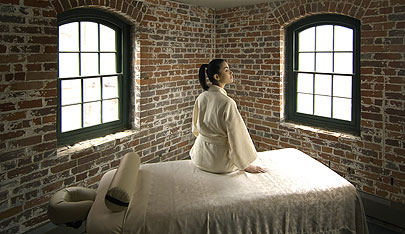| Bras, Spas, Panties and Anorexic Celebrities
The Fashion eZine - Culture
GIRLS GROW UP, AND OUT, SOONER
Anna was alarmed when her 9-year-old daughter complained of chest pain, first on one side and then the other. The doctor's explanation took the Thornhill mother completely by surprise. Jessica, just over 4 feet tall and learning her times tables, had started puberty. Her breasts were developing. And sure enough, it wasn't long before she was kissing her mom goodbye and heading off to Grade 4 with a pink-and-white training bra under her T-shirt. "I was shocked it was happening this early," says Anna, 34, shaking her head. "I don't remember this when we were kids. It was more something that started in middle school." A year later, Jessica, who weighs 67 pounds, still loves skipping with her friends and reading about her favourite mischief-maker Junie B. Jones, is a size 30 AA. There is no doubt she needs the bust support on her tiny frame. She sometimes tries to get away without it by wearing a layered look, but her mom won't let her. Jessica's cool with it, though. After all, more than half of her 10-year-old female classmates wear bras, she reports, grinning through her braces and counting off the names on her fingers. Anna and Jessica aren't their real names, because what 10-year-old really wants her bra size in the newspaper, after all. But the story is true, and echoed by plenty of parents these days who are taken aback at how quickly their daughters seem to be growing up. Studies show girls are physically blossoming earlier. But equally important, they are being socialized to flaunt it – by scantily clad Bratz dolls, celebrities ŕ la Britney and Paris, and retailers peddling size 6X thongs and tight tees with messages like "hottie" scrawled across the chest. In a world driven by consumerism, young girls are tomorrow's shoppers. The earlier marketers can instil brand loyalty, the better, especially as girls approach puberty and become more conscious of their bodies in a world of fashion and beauty products. "They're responding to a physical development that has always been there, but now they're asking them to show it off," says Jennifer Klein, owner of Toronto lingerie boutique Secrets From Your Sister. Klein, 33, has been outfitting young customers with their first bras for the past eight years. She bristles at the messages sent to this impressionable age group that they have to look a certain way and strut their stuff like pop stars. Dr. Jill Hamilton, pediatric endocrinologist at the Hospital for Sick Children, cites research indicating the first physical signs of puberty in girls – breast buds and pubic hair – are occurring an average of one to two years earlier than they did 30 years ago. That means the average is now 10 years old for Caucasian girls and for African-Canadians, who physically mature earlier, age 9. However, research shows the average age of menarche – when a girl gets her first menstrual period – is holding steady at about 12. The trend to earlier physical development has important implications for society as a whole, and for young girls who may be at risk when their bodies mature ahead of their emotional development. (There are no indications of earlier puberty among boys, but difficulties in measuring male development have made it difficult to study.) According to North Carolina researcher Marcia Herman-Giddens, who laid the foundations with her groundbreaking 1997 study of 17,000 U.S. girls, the changing age of puberty onset is an important public health indicator. In a 2004 article in the journal Pediatrics, Herman-Giddens noted it can act as the "canary in the mine" for environmental problems, ranging from the presence of endocrine-disrupting chemicals, to the epidemic of obesity, and other factors affecting overall health. Among physicians, it also determines what should be considered a medical concern. Normal onset of puberty has been considered in the range of 8 to 13 years for girls and 9 through 14 for boys. But Sick Kids' Hamilton says more recent guidelines suggest that medical investigation is no longer warranted unless a Caucasian girl is developing before age 7 and a black girl, under 6. A range of causes for the earlier physical development are under investigation, but the research is still largely inconclusive. Among them: There's good reason these factors are hard to assess on a broad scale. "The triggering of the onset of puberty is a very complex combination of genetic background, environment and hormones," says Hamilton. The most convincing link is between body mass index and time of puberty. The latest study, published in the current issue of Pediatrics, suggests weight in early childhood is a significant factor. The study followed more than 300 girls over a decade and found those heavier at ages 3 and 5 were more likely to reach puberty by age 9. However, it's unclear whether higher body mass sets off puberty earlier, or if excess weight and early puberty are both results of the same underlying condition. For parents, the prospect of an early bloomer can be disconcerting. "It catches them off-guard when a 7-year-old is starting some breast development," says Hamilton. "They are concerned about whether she will be able to (emotionally) handle that." Hamilton stresses that early breast development doesn't necessarily mean menstruation is imminent. Jessica, for example, doesn't have her period yet. Typically, when puberty starts earlier, the process takes longer – three years compared with 18 months for kids who are late bloomers. Dr. Christina Grant, professor and adolescent pediatrician at McMaster Children's Hospital in Hamilton, says the biggest source of anxiety to most girls is when they are developing at rates different than their peers. "They just want to know, `Am I normal?'" Some are afraid, don't feel ready to leave childhood, though they aren't able to express it. Adolescence is a time when girls become increasingly aware of their bodies, are grappling with self-esteem and body image issues and don't want to stand out, especially to the opposite sex. "When you're the only girl in your class who that's happening to, it makes you feel even more different, and that's very tricky," says Grant, a physician in McMaster's eating disorders program. For many of her adolescent patients, self-loathing and skewed body image began when they experienced puberty ahead of their friends. They resented their developing bodies and the accompanying self-consciousness, fear and awkwardness stayed with them – with dangerous results. There are other risks for girls who aren't emotionally prepared for the physical changes. They may attract attention from older boys and feel less conspicuous hanging out with an older crowd, even though they aren't psychologically prepared. And with that, they may feel pressure to take part in riskier behaviour like alcohol and drug use, and sex. This is something Anna worries about: The pressure on girls to act older younger. "I think it's a bad thing," she says. "If a girl needs to be wearing a bra, that's one thing. But they all want to grow up faster. They see all the models in the magazines, and the pop stars and those girls in the music videos, and that's what it's all about. "But I don't want her (Jessica) to think that's what life's all about. I don't want her to think `If I look sexy, then everyone will like me.' I want her to still be a child." Far from being self-conscious, Jessica is happy to gab about puberty. From the sounds of it, a bra is a badge of honour for some girls. Most of her friends were "pretty excited" to get one, she says. "And some girls have them even though they don't really need them." But Jessica still has one foot firmly planted in childhood. No interest in makeup. No racy clothes. And she's miffed that her once squeaky-clean hero Hilary Duff "is turning a little bit bad." Adds Hamilton: "Parents need to realize that even if their body has matured, a 9-year-old is still a 9-year-old emotionally and behaviourally, and to treat them as such."
Talk to your daughters about their changes: These steps recommended by experts can ease a child's transition into puberty:
|
|
|
Beauty is not skin deep for the newest Toronto spas offering holistic treatments and eco-friendly retreats, Judy Gerstel reports
Once upon a time, people went into forests or fields or to the shore to experience nature. They found peace in prayer and contemplated holiness in temples and cathedrals. They turned to family for the comfort and reassurance of the human touch. They stayed well by eating good food and being active and, when healing was in order, they went to the physician or the pharmacy. Now, for all of these and more, they go to spas. No longer is a spa facial merely about moisturizing skin and minimizing pores. Nor is the point of a spa pedicure a polished foot. "We see a pedicure as an hour of having someone look after you," explains Peter Smed, Calgary-based owner of the Oasis Wellness Centre and Spa, opening April 13 in the Distillery District. "It comes down to being touched. People love to be touched. In our model, it's not about the shape of nails and colour," he explains, but rather "a nurturing experience of being looked after and cared for." One reason for making manicures an experience rather than a routine file and polish may be the proliferation of nail "chop shops" on every corner, offering quickies for $20 or less. Spas charging $28 to $48 have to offer more. But, at the newest spas in Toronto, there is also a serious subtext to their raison d'etre. They are not selling superficial beautification or mere pampering. Skin deep is not where spas want to go. They want to get under your skin, sometimes metaphorically, sometimes invasively. Meanwhile, at the other end of the spectrum, the spa concept has been adopted by medical clinics where beautification is very much the point, but with invasive procedures including injections, laser, acupuncture, dermabrasion and staff physicians. "Spas have gone through so many evolutionary stages in the past 15 years," observes Kailee Kline, former (and founding) president of Premier Spas, an association of Ontario spas, and prescient owner of Healthwinds, a midtown Toronto spa now in its 14th year. "Fifteen years ago, people going to spas were the very well-to-do," says Kline. "Seven or eight years ago, the mainstream public got the message about what spas could do in terms of maintaining health, managing stress and wear and tear on bodies and minds." With family doctors increasingly inaccessible and unavailable for more than cursory care or treatment of grave illness, and with religion and family playing a dramatically lesser role in providing support, nurture and healing, spas are taking on a new role. Spas fashioned as retreats are specifically designed to resemble religious sanctuaries or those found in nature – quiet, stillness, natural materials and an eco-friendly, uplifting environment prevail. Holistic has replaced holy. Yoga teachers, practitioners of ancient healing, and therapists (massage, for now, but can spa psychologists be far behind?) function as the priestly guides to peace and serenity. "Designed to reconnect mind, body and spirit," boasts the Oasis about its products, resources and holistic treatments. It bills itself as a "23,000-square-foot urban retreat." "This is not a spa. This is the un-spa," insists Dan Thompson, creative director of Teye International, the exclusive cosmetics line for Oasis. At 889 Yonge (the name as well as the address), which opened last week and celebrates its official grand opening on Saturday, co-owner Christine Russell also renounces the word "spa," calling her business "one step beyond the traditional spa experience ... somewhere people would feel really good from the inside." "It's a yoga and holistic lifestyle company, an integrated experience to educate and empower people in taking a progressive approach to their health and their life as a whole person." she explains. It's a mission as much as a business plan and includes a dedicated green initiative detailed on the website (889yonge.com): energy-saving renovation of the Victorian building using the existing hardwood floor where possible, green design with eco-friendly carpeting and textiles, green operation with Bullfrog power, a goal of no waste, and an environment free of chemicals and toxins. "It provides a healthy-feeling place for people to come for their yoga and treatments," says Russell. "Part of our offering is holistic treatments – body, facial, massage and ancient healing, shiatsu, ayurvedic head massage, acupuncture." A facial at 889 Yonge is very much a head treatment and may be followed by a consultation with Dr. Rose Liu, the Chinese medicine practitioner on staff. Rejuvenation, relaxation and healing are how Lynn Shulman describes the mission of Elixir Organic Spa, which she opened four years ago. Services include microdermabrasion and manicures – the polish is the only non-organic product in the place. "Because we use all organic," explains Shulman, "the energy of the plants and essential oils and herbs creates an ambience where people automatically feel relaxed and at ease." At the same time traditional spas are moving away from beauty treatments and pampering and focussing more on health and wellness, and on the mind as well as the body, cosmetic medicine is moving away from its cool, clinical origins and offering the traditional spa's cosseting and luxury surroundings. The 10-month old Skin Medical Spa is billed as "a new genre of wellness spas, combining the elements of a traditional spa setting with the safety and superior clinical expertise of the medical profession." Founder and director Nitasha Sarin explains that, despite her business name, her York St. facility differs from a standard spa because "it's more of a result-oriented medical approach." Sarin, 28, says the business plan grew out of her own experience as an adolescent with skin problems, getting two minutes and a prescription from a dermatologist. Meanwhile, she recalls, "the people who would give you lots of attention (concerning your skin) at the pampering spas were people who went to school to learn how to do manicures and pedicures." Skin Medical Spa, says Sarin, offers a customized approach, integrating medical procedures including injections with ayurvedic skin care and with "nutritional detox counselling and how you can affect skin by internal cleansing." With both the therapeutic and medical models, spas are coming full circle to their origin – Spa, Belgium, where mineral springs were thought to be medicinal. Spas were where people went for hydrotherapy to treat both physical and nervous conditions but also, in Switzerland and other countries, for treatment of tuberculosis. They were, in the beginning, destinations for wealthy aristocrats but, as has recently happened in North America, the clientele changed. "What the new spa guests brought was not fever, not acute infectious illness as the aristocracy had before," writes medical historian Edward Shorter about 19th century Germany, "but neurosis."
ROME–Allegra Beck Versace, the 20-year-old heiress to the fashion house that bears her name, is suffering from anorexia, the eating disorder that many people blame at least in part on the diktats of the beauty industry. "Our daughter, Allegra has been battling anorexia, a very serious disease, for many years," Donatella Versace said in a joint statement released with Allegra's father Paul Beck. Allegra inherited 50 per cent of Versace on her 18th birthday from her uncle Gianni. The fashion pioneer was gunned down in 1997 outside his Miami Beach mansion by serial killer Andrew Cunanan. "She is receiving the best medical care possible to help overcome this illness and is responding well," said the statement by Donatella, who owns 20 per cent of the firm and took over as designer after her brother's death. "Allegra is not at present staying in any hospital, she is living in her private residence and her condition does not cause particular concerns," it said. "As parents, we are doing our best to protect our daughter. However, due to numerous media reports, we want to let everyone know that we appreciate their concern for Allegra, and we ask that her privacy be respected at this time," they said. Anorexia is an eating disorder whereby sufferers starve themselves due to an obsessive fear of getting fat. It has the highest fatality rate of any psychiatric illness, with 13 to 18 per cent of sufferers dying, most commonly due to heart disease or suicide, experts in Britain say.
Three brazen shoplifters made off with nearly $12,000 (all figures U.S.) in women's underwear by stuffing the goods into bags designed to foil anti-theft equipment at a Victoria's Secret store last week, police said. Surveillance cameras captured two men and one woman jamming undergarments into large bags and walking past customers and staff into the Newport Center Mall in Jersey City, N.J. Police said the thieves took panties valued at more than $6,900 and bras valued at about $4,900. Victoria's Secret bras retail from $30 to more than $50. Panties cost between $5 and $20, according to the company's website. No arrests have been made since the crime was reported, said Lt. Edgar Martinez, spokesperson for the Jersey City police department. "This isn't something we've seen before. It's a lot of underwear to take," said Martinez.
| |

 Heaven and Earth Beauty Spas
Heaven and Earth Beauty Spas
 Versace heiress battles anorexia
Versace heiress battles anorexia
 Panty raid at Victoria's Secret
Panty raid at Victoria's Secret